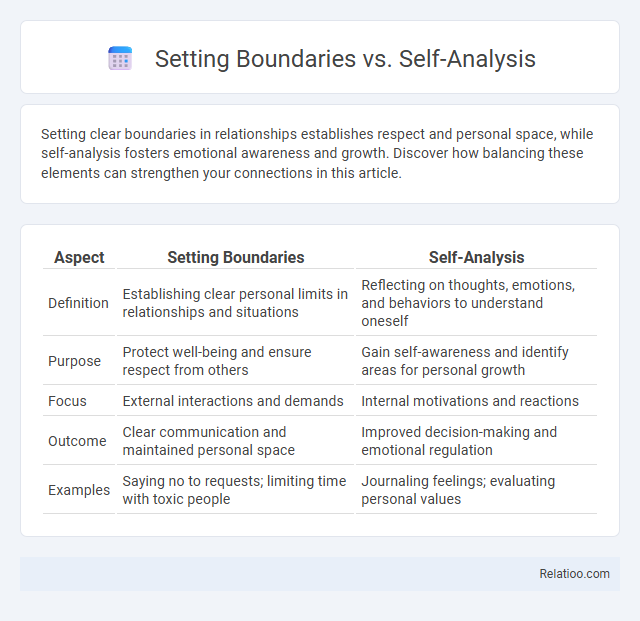Setting clear boundaries in relationships establishes respect and personal space, while self-analysis fosters emotional awareness and growth. Discover how balancing these elements can strengthen your connections in this article.
Table of Comparison
| Aspect | Setting Boundaries | Self-Analysis |
|---|---|---|
| Definition | Establishing clear personal limits in relationships and situations | Reflecting on thoughts, emotions, and behaviors to understand oneself |
| Purpose | Protect well-being and ensure respect from others | Gain self-awareness and identify areas for personal growth |
| Focus | External interactions and demands | Internal motivations and reactions |
| Outcome | Clear communication and maintained personal space | Improved decision-making and emotional regulation |
| Examples | Saying no to requests; limiting time with toxic people | Journaling feelings; evaluating personal values |
Understanding Boundaries: Definition and Importance
Understanding boundaries is crucial for maintaining healthy relationships and protecting your emotional well-being by clearly defining what is acceptable and unacceptable behavior from others. Unlike self-analysis, which involves examining your thoughts and motives, and introspection, which reflects on your internal experiences, setting boundaries actively enforces limits to safeguard your personal space and values. Recognizing and respecting these limits enhances your self-respect and prevents emotional burnout.
What is Self-Analysis? Exploring Inner Reflection
Self-analysis involves a deliberate, structured examination of one's thoughts, emotions, and behaviors to gain deeper self-awareness and identify patterns influencing personal decisions. Unlike setting boundaries, which focuses on managing interactions with others, self-analysis centers on internal reflection and critical evaluation of one's mental and emotional processes. Introspection shares similarities but tends toward spontaneous, less structured contemplation, whereas self-analysis employs systematic methods like journaling or therapeutic techniques for comprehensive inner insight.
The Psychological Benefits of Setting Boundaries
Setting boundaries enhances your mental health by reducing stress and preventing burnout through clear limits on what is acceptable from others. Unlike self-analysis and introspection, which focus on internal reflection, boundaries create external structures that protect emotional well-being and foster healthier relationships. Establishing boundaries empowers you to prioritize personal needs and maintain a balanced psychological state.
How Self-Analysis Enhances Personal Growth
Self-analysis enhances personal growth by allowing you to critically evaluate your thoughts, behaviors, and emotions, leading to increased self-awareness and informed decision-making. Unlike setting boundaries, which protects your external environment, self-analysis focuses on internal reflection to identify areas for improvement and emotional regulation. Introspection deepens this process by encouraging a consistent habit of self-examination, ultimately fostering resilience and a stronger sense of identity.
Boundaries vs Self-Analysis: Core Differences
Setting boundaries involves establishing clear limits to protect personal space and emotional well-being, while self-analysis is a cognitive process focused on examining one's thoughts, emotions, and behaviors for self-improvement. Boundaries are external frameworks that dictate acceptable interactions with others, whereas self-analysis is an internal method for understanding one's motives and patterns. The core difference lies in boundaries managing external relationships and self-analysis navigating internal self-awareness.
Signs You Need Better Boundaries or More Self-Analysis
Persistent feelings of overwhelm, resentment, or burnout often signal that Your boundaries need reinforcement to protect Your emotional energy and personal space. Repeated patterns of stress, confusion, or dissatisfaction may indicate a need for deeper self-analysis to understand underlying motivations, fears, or desires influencing Your behavior. Recognizing these signs empowers You to balance external limits with internal reflection for healthier decision-making and emotional resilience.
Common Challenges in Setting Boundaries and Practicing Self-Analysis
Struggling with setting boundaries often stems from fear of conflict or disappointing others, leading to emotional exhaustion and resentment. Practicing self-analysis presents challenges such as bias, lack of objectivity, and difficulties in identifying true motivations or patterns in behavior. Both require consistent effort and self-awareness to navigate emotional discomfort and develop healthier interpersonal dynamics.
Practical Strategies for Healthy Boundaries
Setting boundaries requires clear communication and consistent enforcement to protect your emotional well-being and personal space. Self-analysis helps you recognize your limits and triggers, enabling you to define what is acceptable in relationships and work environments. Introspection supports ongoing reflection, ensuring your boundaries adapt as your needs evolve for sustained mental health.
Effective Techniques for Meaningful Self-Reflection
Setting boundaries involves clearly defining your limits to protect emotional well-being, while self-analysis requires objectively examining your thoughts and behaviors for growth. Introspection delves deeper into understanding your core motivations and values through honest self-examination. You can enhance meaningful self-reflection by combining journaling techniques with mindfulness practices and regular feedback from trusted sources, ensuring balanced insights and personal development.
Integrating Boundaries and Self-Analysis for Holistic Wellbeing
Integrating boundaries with self-analysis enhances holistic wellbeing by fostering self-awareness and protecting mental health through clear limits on external influences. Establishing personal boundaries provides a framework for emotional regulation, while self-analysis encourages reflective understanding of inner motivations and behaviors. Together, they create a balanced approach that supports emotional resilience and promotes sustainable personal growth.

Infographic: Setting Boundaries vs Self-Analysis
 relatioo.com
relatioo.com